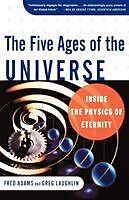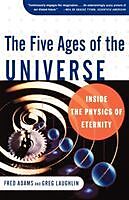The Five Ages of the Universe
Einband:
Kartonierter Einband
EAN:
9780684865768
Untertitel:
Inside the Physics of Eternity
Autor:
Fred Adams, Greg Laughlin
Herausgeber:
Free Press
Anzahl Seiten:
288
Erscheinungsdatum:
01.06.2000
ISBN:
0684865769
Zusatztext Susan Okie The Washington Post Marvelous descriptive writing and mind-expanding explanations....What makes it even better than good science fiction is that it's true. Informationen zum Autor Fred Adams received his Ph.D. from the University of California. Recipient of the Helen B. Warner Prize, Adams is a professor of physics at the University of Michigan and lives in Ann Arbor, Michigan. Klappentext As the twentieth century closed, Fred Adams and Greg Laughlin captured the attention of the world by identifying the five ages of time. In The Five Ages of the Universe, Adams and Laughlin demonstrate that we can now understand the complete life story of the cosmos from beginning to end.Adams and Laughlin have been hailed as the creators of the definitive long-term projection of the evolution of the universe. Their achievement is awesome in its scale and profound in its scientific breadth. But The Five Ages of the Universe is more than a handbook of the physical processes that guided our past and will shape our future; it is a truly epic story.Without leaving earth, here is a fantastic voyage to the physics of eternity. It is the only biography of the universe you will ever need. Leseprobe Introduction A guide to the big picture, fundamental physical law, windows of space and time, the great war, and extremely big numbers. January 1, 7,000,000,000 A.D., Ann Arbor: The New Year rings in little cause for celebration. Nobody is present even to mark its passing. Earth's surface is a torrid unrecognizable wasteland. The Sun has swelled to enormous size, so large that its seething red disk nearly fills the daytime sky. The planet Mercury and then Venus have already been obliterated, and now the tenuous outer reaches of the solar atmosphere are threatening to overtake the receding orbit of Earth. Earth's life-producing oceans have long since evaporated, first into a crushing, sterilizing blanket of water vapor, and then into space entirely. Only a barren rocky surface is left behind. One can still trace the faint remains of ancient shorelines, ocean basins, and the low eroded remnants of the continents. By noon, the temperature reaches nearly 3000 degrees Fahrenheit, and the rocky surface begins to melt. Already, the equator is partly ringed by a broad glowing patchwork of lava, which cools to form a thin gray crust as the distended Sun eases beneath the horizon each night. A patch of the surface which once cradled the forested moraines of southeastern Michigan has seen a great deal of change over the intervening billions of years. What was once the North American continent has long since been torn apart by the geologic rift which opened from Ontario to Louisiana and separated the old stable continental platform to produce a new expanse of sea floor. The sedimented, glaciated remains of Ann Arbor were covered by lava which arrived from nearby rift volcanos by coursing through old river channels. Later, the hardened lava and the underlying sedimentary rock were thrust up into a mountain chain as a raft of islands the size of New Zealand collided with the nearby shoreline. Now, the face of an ancient cliff is weakened by the Sun's intense heat. A slab of rock cleaves off, causing a landslide and exposing a perfectly preserved fossil of an oak leaf. This trace of a distant verdant world slowly melts away in the unyielding heat. Soon the entire Earth will be glowing a sullen, molten red. This scenario of destruction is not the lurid opening sequence from a grade B movie, but rather a more or less realistic description of the fate of our planet as the Sun ends its life as a conventional star and expands to become a red giant. The catastrophic melting of Earth's surface is just one out of a myriad of events that are waiting to occur as the universe and its contents grow older. Right now, the univers...
Susan Okie The Washington Post Marvelous descriptive writing and mind-expanding explanations....What makes it even better than good science fiction is that it's true.
Autorentext
Fred Adams received his Ph.D. from the University of California. Recipient of the Helen B. Warner Prize, Adams is a professor of physics at the University of Michigan and lives in Ann Arbor, Michigan.
Klappentext
As the twentieth century closed, Fred Adams and Greg Laughlin captured the attention of the world by identifying the five ages of time. In The Five Ages of the Universe, Adams and Laughlin demonstrate that we can now understand the complete life story of the cosmos from beginning to end. Adams and Laughlin have been hailed as the creators of the definitive long-term projection of the evolution of the universe. Their achievement is awesome in its scale and profound in its scientific breadth. But The Five Ages of the Universe is more than a handbook of the physical processes that guided our past and will shape our future; it is a truly epic story. Without leaving earth, here is a fantastic voyage to the physics of eternity. It is the only biography of the universe you will ever need.
Leseprobe
Introduction
A guide to the big picture, fundamental physical law, windows of space and time, the great war, and extremely big numbers.
January 1, 7,000,000,000 A.D., Ann Arbor:
The New Year rings in little cause for celebration. Nobody is present even to mark its passing. Earth's surface is a torrid unrecognizable wasteland. The Sun has swelled to enormous size, so large that its seething red disk nearly fills the daytime sky. The planet Mercury and then Venus have already been obliterated, and now the tenuous outer reaches of the solar atmosphere are threatening to overtake the receding orbit of Earth.
Earth's life-producing oceans have long since evaporated, first into a crushing, sterilizing blanket of water vapor, and then into space entirely. Only a barren rocky surface is left behind. One can still trace the faint remains of ancient shorelines, ocean basins, and the low eroded remnants of the continents. By noon, the temperature reaches nearly 3000 degrees Fahrenheit, and the rocky surface begins to melt. Already, the equator is partly ringed by a broad glowing patchwork of lava, which cools to form a thin gray crust as the distended Sun eases beneath the horizon each night.
A patch of the surface which once cradled the forested moraines of southeastern Michigan has seen a great deal of change over the intervening billions of years. What was once the North American continent has long since been torn apart by the geologic rift which opened from Ontario to Louisiana and separated the old stable continental platform to produce a new expanse of sea floor. The sedimented, glaciated remains of Ann Arbor were covered by lava which arrived from nearby rift volcanos by coursing through old river channels. Later, the hardened lava and the underlying sedimentary rock were thrust up into a mountain chain as a raft of islands the size of New Zealand collided with the nearby shoreline.
Now, the face of an ancient cliff is weakened by the Sun's intense heat. A slab of rock cleaves off, causing a landslide and exposing a perfectly preserved fossil of an oak leaf. This trace of a distant verdant world slowly melts away in the unyielding heat. Soon the entire Earth will be glowing a sullen, molten red.
This scenario of destruction is not the lurid opening sequence from a grade B movie, but rather a more or less realistic description of the fate of our planet as the Sun ends its life as a conventional star and expands to become a red giant. The catastrophic melting of Earth's surface is just one out of a myriad of events that are waiting to occur as the universe and its contents grow older.
Right now, the universe is still in its adolescence with an age of ten to fifteen billion years. As a result, not enough time has elapsed for …

Leider konnten wir für diesen Artikel keine Preise ermitteln ...
billigbuch.ch sucht jetzt für Sie die besten Angebote ...
Die aktuellen Verkaufspreise von 6 Onlineshops werden in Realtime abgefragt.
Sie können das gewünschte Produkt anschliessend direkt beim Anbieter Ihrer Wahl bestellen.
Loading...
Die aktuellen Verkaufspreise von 6 Onlineshops werden in Realtime abgefragt.
Sie können das gewünschte Produkt anschliessend direkt beim Anbieter Ihrer Wahl bestellen.
| # | Onlineshop | Preis CHF | Versand CHF | Total CHF | ||
|---|---|---|---|---|---|---|
| 1 | Seller | 0.00 | 0.00 | 0.00 |
